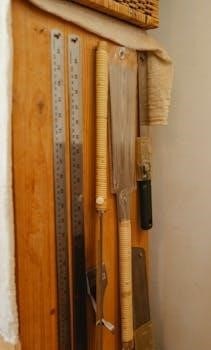
HY3020E DC Power Supply Manual⁚ An Overview
This manual serves as a comprehensive guide for the HY3020E DC power supply, detailing its features, operation, safety, and troubleshooting. It ensures safe usage and optimal performance for all users.
The HY3020E DC power supply is a regulated power source designed for a wide range of electronic applications. Known for its stability and reliability, it provides a continuously adjustable output voltage and current, catering to diverse testing and experimentation needs. This unit employs coarse and fine controls for precise adjustments, ensuring accurate voltage and current settings.
This power supply falls under the HY3000 series, recognized for delivering consistent and dependable power. Its robust design makes it suitable for both laboratory and educational environments. Users can confidently rely on the HY3020E for stable DC power in various projects and experiments. Safety features are incorporated to protect both the user and the equipment connected to it. The included manual offers thorough guidance for operation and maintenance.
Purpose of the User Manual
This user manual serves as a comprehensive guide for operating the HY3020E DC power supply safely and effectively. It provides detailed instructions on setting up, using, and maintaining the device, ensuring users understand its capabilities and limitations. The manual outlines essential safety precautions to prevent damage to the power supply and connected equipment, as well as to protect the user from potential hazards.
Furthermore, this manual offers troubleshooting tips for common issues, helping users diagnose and resolve problems efficiently. It includes information on fuse replacement and clarifies the function of coarse and fine controls for precise voltage and current adjustments. By following the guidelines in this manual, users can maximize the lifespan and performance of their HY3020E DC power supply. The manual is an indispensable resource for both novice and experienced users.

Key Features and Specifications
Explore the HY3020E DC power supply’s key features and specifications. This section details voltage/current ranges, control types, and performance metrics, ensuring users understand its capabilities for varied applications.
Voltage and Current Adjustment
The HY3020E DC power supply provides precise control over both voltage and current outputs, allowing users to tailor the power supply to meet specific circuit requirements. Understanding the adjustment mechanisms is crucial for effective use. This unit features continuously adjustable voltage and current, promoting flexibility.
Users can modify the voltage and current using dedicated knobs. The voltage adjustment enables setting the desired voltage level, while current adjustment limits the maximum current output. This is important for protecting circuits under test from overcurrent conditions.
The HY3020E includes both coarse and fine adjustments for enhanced precision. These controls are beneficial when a specific voltage or current is needed. By using these adjustments, users can accurately set the power supply.
The power supply’s ability to provide accurate voltage and current is one of its key advantages, making it suitable for a variety of electronic projects and experiments. Proper adjustment ensures stable and reliable operation for all connected devices.
Coarse and Fine Controls
The HY3020E DC power supply features both coarse and fine control knobs for precise voltage and current adjustments. These controls allow users to quickly set approximate values with the coarse knob and then fine-tune the output with the fine knob.
The coarse control offers larger adjustments, enabling users to quickly reach the desired voltage or current range. It is ideal for initial settings when accuracy is not immediately critical. The fine control, on the other hand, allows for minute adjustments, ensuring precise output settings.
Using both coarse and fine controls together provides an efficient way to achieve the required voltage or current output. This dual-control system is very helpful for sensitive electronic components that require exact power levels.
Effectively utilizing the coarse and fine controls maximizes the utility of the HY3020E, ensuring stable, accurate, and repeatable results in any testing or experimental setup. Practice with both controls will improve overall proficiency with the power supply.

Operating Instructions
This section details the operational procedures for the HY3020E DC power supply. It covers powering on/off, setting voltage, connecting loads, and ensuring safe and efficient operation.
Powering On and Off
To power on the HY3020E DC power supply, ensure the power line cord is securely connected to both the power supply and a suitable power outlet. Verify that the voltage selector switch, if present, is set to the correct voltage for your region. Next, locate the ON/OFF switch, typically found on the front panel. Flip the switch to the ON position. The power supply’s display should illuminate, indicating that it is receiving power.
To power off the HY3020E, simply flip the ON/OFF switch to the OFF position. The display should turn off, indicating that the power supply is no longer providing power. It is recommended to disconnect the power line cord from the outlet if the power supply will not be used for an extended period. This helps to prevent any potential electrical hazards and conserves energy. Always ensure that any connected loads are safely disconnected before powering off the device.
Setting the Output Voltage
The HY3020E DC power supply allows precise adjustment of the output voltage. First, ensure the power supply is turned on. Locate the voltage adjustment knobs on the front panel, typically labeled as “coarse” and “fine.” The “coarse” knob allows for larger voltage adjustments, while the “fine” knob provides more precise control. Begin by using the “coarse” knob to set the approximate desired voltage. Observe the voltage display on the power supply.
Next, use the “fine” knob to fine-tune the voltage to the exact desired level. The display will update in real-time as you adjust the knob. If you need to decrease the voltage, turn the knobs counter-clockwise; to increase it, turn them clockwise. For accurate voltage settings, it is advisable to use an external multimeter to verify the output voltage, especially for sensitive applications. Always double-check the polarity before connecting any load.
Connecting the Load
Before connecting any load to the HY3020E DC power supply, ensure that the power supply is turned off to prevent any accidental voltage spikes or damage to the connected device. Identify the positive (+) and negative (-) output terminals on the front panel of the power supply. These terminals are typically marked with red (+) and black (-) symbols, respectively. Ensure you know the polarity requirements of your load.
Using appropriate connecting wires, connect the positive terminal of the power supply to the positive terminal of your load, and the negative terminal of the power supply to the negative terminal of your load. Double-check all connections to ensure they are secure and properly aligned. Avoid any loose connections or short circuits. After verifying all connections, you can turn on the power supply and gradually increase the voltage to the desired level, monitoring both the voltage and current readings on the power supply display.

Safety Precautions and Warnings
This section outlines crucial safety measures for operating the HY3020E DC power supply. Adhering to these precautions minimizes risks of electrical shock, fire, or damage to equipment.
General Safety Guidelines
Always disconnect the power supply from the main AC power source before performing any maintenance or repairs. Never operate the device in wet or damp environments, as this increases the risk of electric shock. Ensure proper ventilation around the power supply to prevent overheating. Avoid placing flammable materials near the device during operation. Use only the specified power line cord to avoid potential hazards.
Regularly inspect the power cord for damage, and replace it if necessary. Do not exceed the maximum voltage and current ratings of the power supply. Be aware of the polarity of the output terminals. Avoid short-circuiting the output terminals. Do not attempt to disassemble or modify the power supply, as this could void the warranty and create safety hazards. If the device malfunctions, contact qualified personnel for repair. Always supervise when in use around children.
Fuse Replacement Information
If the power supply fails to operate, the fuse may have blown. Before replacing the fuse, disconnect the power supply from the AC power source. Locate the fuse holder, typically found on the rear panel of the device near the power cord connector. Use a screwdriver to carefully open the fuse holder. Remove the blown fuse and inspect it. Ensure you replace the fuse with one of the correct type and rating as specified in the manual.
Using a fuse with a higher rating can damage the power supply and create a fire hazard. Insert the new fuse into the fuse holder and close it securely. Reconnect the power supply to the AC power source and test its operation. If the fuse blows again immediately, there is likely a more serious problem. Contact qualified personnel for repair and do not continue replacing fuses.

Troubleshooting
This section provides guidance on resolving common issues encountered while operating the HY3020E DC power supply. Refer to this section before seeking professional assistance for repair matters.
Common Issues and Solutions
This section addresses frequent problems users might face with the HY3020E DC power supply, offering practical solutions for each. One common issue is the power supply not turning on. Ensure the power line cord is securely connected and the power switch is in the “ON” position. If it still fails, inspect the fuse and replace it if necessary, following the fuse replacement guidelines. Another issue involves unstable voltage output. Verify that the load is within the power supply’s specified current and voltage limits. If the output voltage fluctuates, check the coarse and fine voltage controls. If the power supply is overheating, ensure proper ventilation around the unit to prevent overheating. For further assistance, consult the user manual or contact technical support. Always disconnect the power supply before attempting any repairs or replacements. Regular maintenance and careful operation will minimize potential problems and extend the lifespan of your HY3020E DC power supply.
Included Components
The HY3020E package includes a power line cord for connection, a spare fuse for maintenance, and the essential instruction manual for proper operation and safety guidelines.
Power Line Cord
The power line cord supplied with the HY3020E DC power supply is a crucial component, designed to safely connect the device to a standard electrical outlet. It’s essential to inspect the cord for any signs of damage, such as cuts or frayed wires, before each use. Using a damaged power cord can pose a significant electrical hazard and should be avoided at all costs.
Ensure that the power outlet you intend to use is compatible with the voltage requirements of the HY3020E power supply, as specified in the user manual. Never attempt to modify the power cord or use adapters that are not specifically designed for this purpose. Always plug the power cord directly into a grounded outlet to ensure proper grounding and prevent electrical shock.
When disconnecting the power cord, always grasp the plug itself, rather than pulling on the cord, to avoid damage. Store the power cord carefully when not in use, avoiding sharp bends or kinks. If the power cord becomes damaged, replace it with a new cord that meets the specifications outlined in the HY3020E user manual. This will ensure the continued safe and reliable operation of your power supply.
Spare Fuse
The HY3020E DC power supply includes a spare fuse, an essential safety component designed to protect the device from overcurrent situations. The fuse is a sacrificial element that breaks the electrical circuit when the current exceeds a safe level, preventing damage to the power supply and connected equipment. It is crucial to use the correct type and rating of fuse as specified in the user manual; using an incorrect fuse can compromise safety and potentially damage the power supply.
The spare fuse is provided for immediate replacement in case the original fuse blows. If the power supply stops working, always check the fuse first. Before replacing the fuse, disconnect the power supply from the mains and identify the cause of the blown fuse to prevent recurrence.
Replacing the fuse is a simple process, but it must be done carefully following the instructions in the manual. Ensure the replacement fuse is of the same type and rating. If the fuse blows repeatedly, it indicates a more serious problem that requires professional attention. Do not attempt to bypass the fuse, as this can create a fire hazard and void the warranty.